This post may contain affiliate links. Please see our disclosure policy.
Canning meal-in-a-jar recipes is the ultimate meal prep! These tasty, nutritious recipes are easy to grab and eat, whether you’re dealing with a busy workday or a power outage.
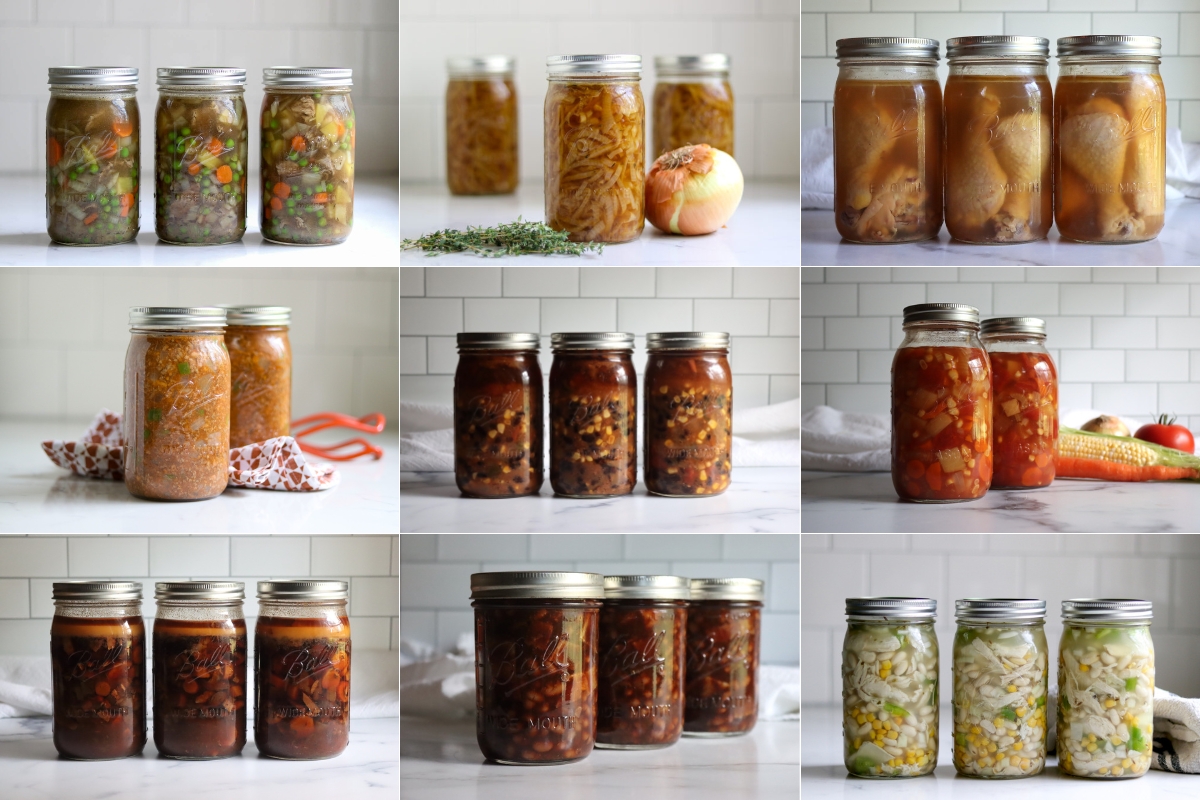
Many homesteaders start their canning journey by water bath canning jam or pickles, sometimes moving up to pressure canning fresh vegetables from the garden. This is a whole different ball game.
These recipes will leave you with a whole meal rather than just individual ingredients. In today’s busy world, this can make a huge difference in sticking to home-cooked food.
While I still love canning versatile ingredients like green beans, carrots, potatoes, and beef, these ready-to-eat meals are priceless. I love grabbing one from the shelf when we’ve had a late night. It makes the difference between a healthy, hearty meal and takeout.
To ensure your family takes advantage of these prepared meals, it’s important to find various recipes that meet two criteria. First, if you have an abundance of a particular ingredient like beef or venison, you’ll need ways to use it. Second, you need recipes that your family will enjoy.
That’s why you need a good selection of meal-in-a-jar recipes.
Fortunately for you, I’ve got you covered! I’ve gathered every good meal-in-a-jar recipe I could find.
(And if you want to create your own meal in a jar canning recipe, I have a guide for that too!)
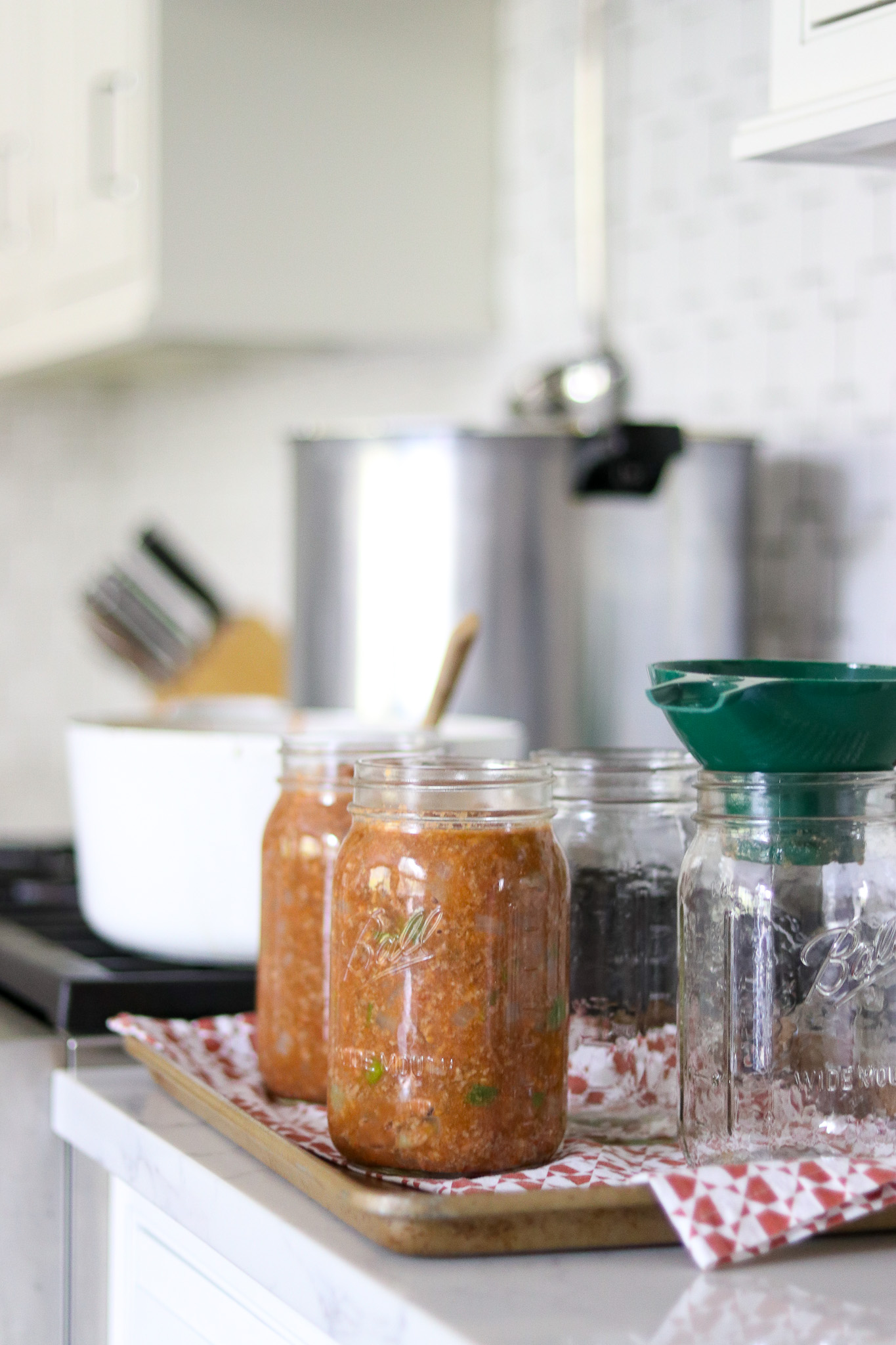
Guidelines for Canning Meals in a Jar
Canning can make some people nervous and is sometimes portrayed as complicated or risky. I disagree; canning isn’t scary or complex, but just like when preparing other basic foods like chicken breast, there are a few rules you should follow. Before I list the recipes, I will quickly go over what’s safe and what’s not when canning meals in a jar.
Every recipe in this list is designed for pressure canning. Water bath canning recipes are fine for simple acidic products like jam and pickles, but they aren’t safe for these multi-ingredient recipes that compose an entire meal.
If you’re new to pressure canning, check out my beginner’s guide.
To get started with pressure canning, you’ll need a few supplies, including a good-quality pressure canner. My favorite is the 30-quart All-American Brand Pressure Canner. I haven’t found another that matches its quality. You can find the other necessities and helpful tools in my canning supplies article.
While a pressure canner seems like a miracle worker in the kitchen, there are a few ingredients that are never safe to can! Unfortunately, these ingredients have recently been featured on social media canning recipes, so it’s essential to understand basic canning safety.
Canning recipes should never include:
- Dairy products, including milk, cheese, butter
- Coconut milk, oat milk, and other plant-based milks
- Eggs, including pickled eggs
- Rice, pasta, and other starchy foods
- Flour, corn starch, and most other thickeners (Canning Clear Jel is the only exception)
Thankfully, all of these ingredients are usually easy to add at serving time. For example, when I use my Beef Stroganoff, I cook some pasta to serve it over while the stroganoff is heating.
The same goes for canning vindaloo curry. If I’m serving it over rice, I’ll cook some rice while the curry is heating.
As mentioned above, most thickeners except Canning Clear Jel aren’t safe to can. While I sometimes use Canning Clear Jel for pie filling, I don’t use it for savory meals. Some people like it, but I find it has a gooey, pie-filling-like texture. Thankfully, it’s no trouble for me to quickly thicken chicken marsala and other similar recipes as they heat on the stove.
If you’re worried about keeping these other ingredients on hand in case of emergencies, many of the non-perishable items, like rice and pasta, store well in jars and food-grade five-gallon buckets.
The perishable items are a little trickier, but you can find shelf-stable versions of perishable pantry items that don’t require refrigeration.
These options are great for emergency food storage.
Lastly, if you live above 1,000 feet in elevation, you’ll need to adjust the pressure in your recipes to ensure your meal-in-a-jar recipes are processed correctly. Read the guide for altitude adjustments for pressure canning.
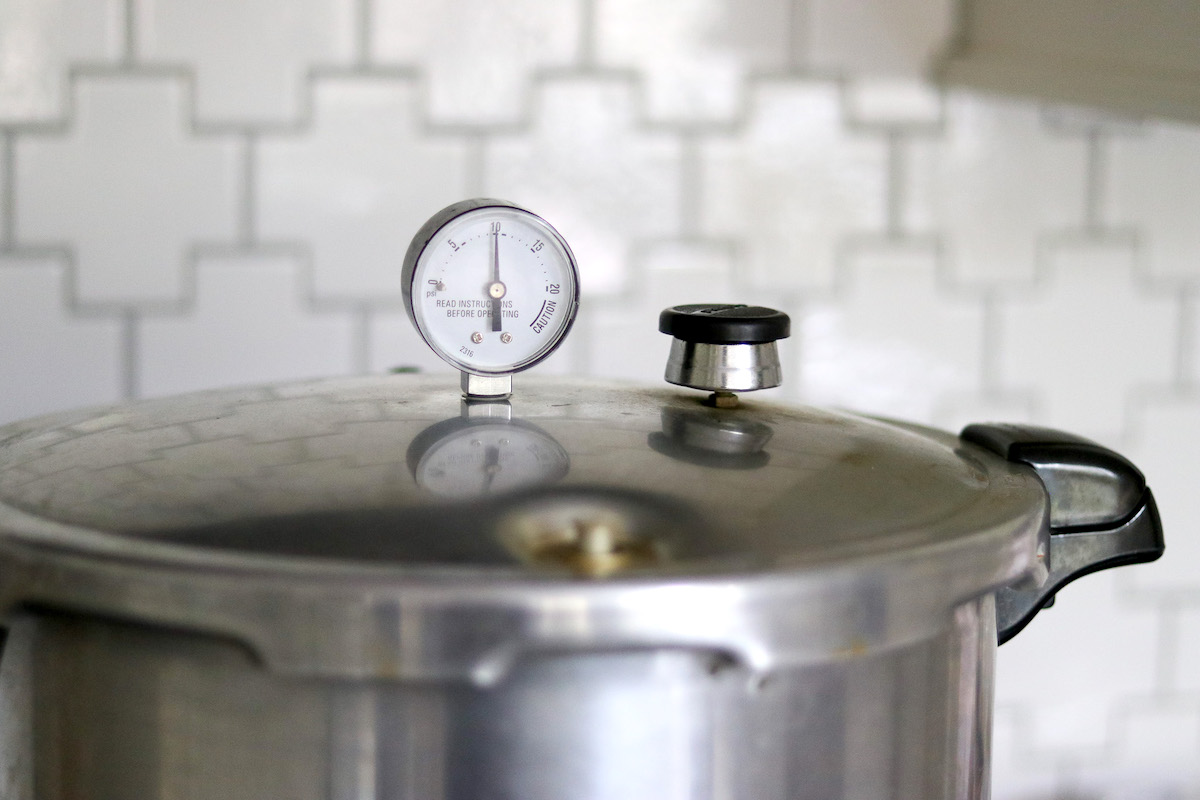
Meal in a Jar Canning Recipes
If you’re ready to start putting up meal-in-a-jar recipes, you’re in luck. I collected all the recipes I could find and listed them in categories. There are plenty of hearty recipes such as chili, stews, sandwich fillings, soups, and more.
Of course, there are also many great recipes that aren’t available online. Some of my favorite recipes are from canning books.
Pressure Canning for Beginners and Beyond by Angi Schneider is my absolute favorite canning book. It has many unique, delicious meal-in-a-jar recipes perfect for filling the pantry.
One reason I rank Angi’s books so highly is that she works hard to ensure that all of her recipes are safe and approved for home canning. In my opinion, if you’re looking for tasty, safe meal-in-a-jar recipes, it’s worth picking up her book; you won’t find her recipes on the internet.
I also use Diane Devereaux’s The Complete Guide to Pressure Canning for inspiration. However, this book requires familiarity with canning safety, as it sometimes lists unsafe ingredients like coconut milk.
Additionally, she uses clear jel thickener in her soups. It is safe, but you may find, as I did, that the texture isn’t great.
That said, Diane still has some creative recipes that can be a great source of information. However, if you only get one book, make it Angi’s Pressure Canning for Beginners and Beyond.
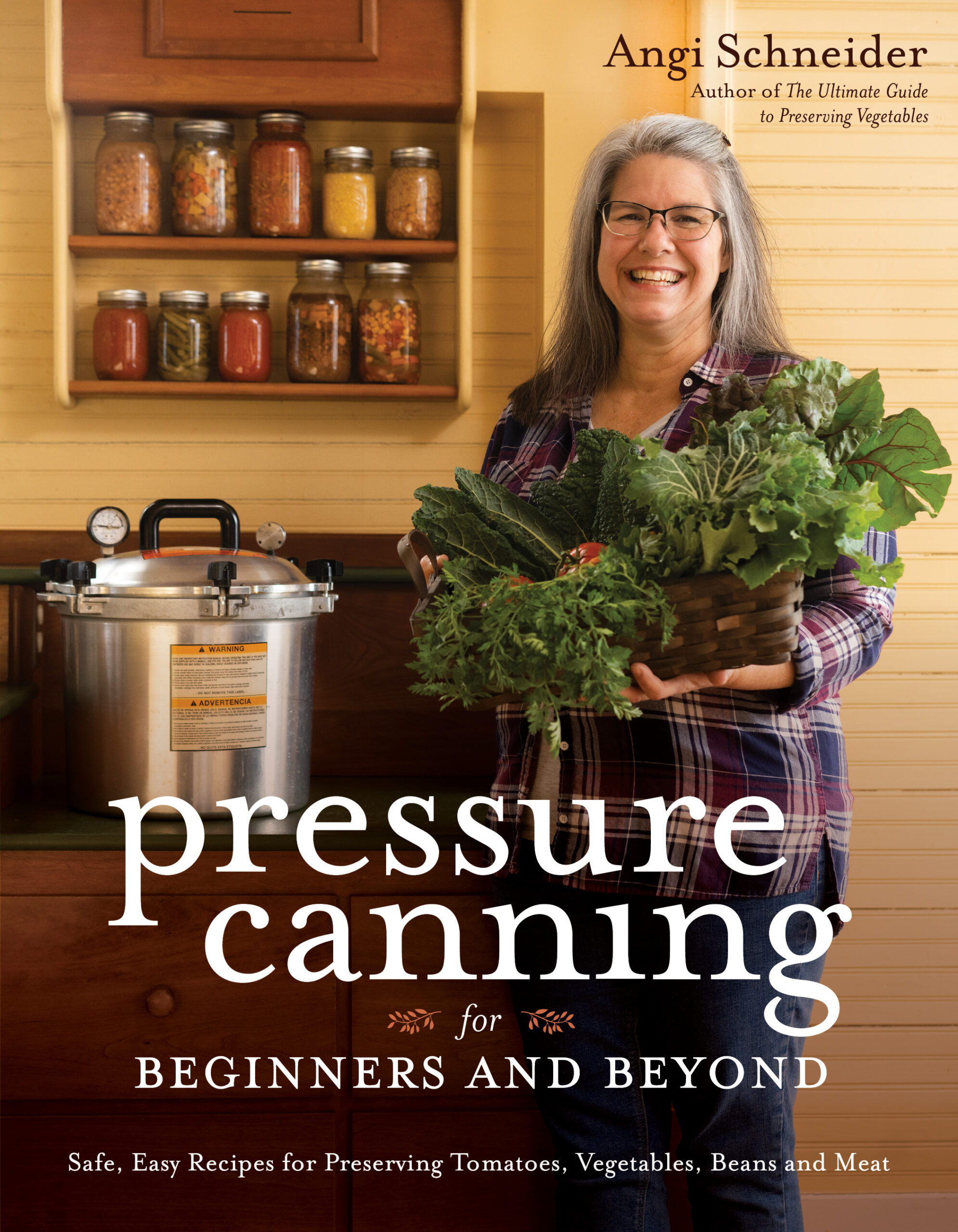
Hearty Meat Dinners
These meal-in-a-jar recipes work well for meals based around seasoned meat. Some, like soup or stew, can be the whole meal. Others are just the main course and pair really well with other canned products like corn or potatoes. A few are excellent served with rice, pasta, tortilla chips, or other non-perishables we often keep on hand.
Rather than having an overwhelming list, I decided to break it down into categories based on different types of meat. You will also find a vegetarian mains section at the end.
Beef
Beef meal-in-a-jar recipes are hearty and filling and an excellent way to preserve extra meat for easy use later on. These recipes will also work with other types of red meat, like venison, moose, veal, or bear. You can also pressure can pork exactly the way you do beef, so you can safely substitute it in any of these.
Using a pressure canner, it’s simple and safe to can beef as steaks, cubes, ground meat, or slices. Usually, I can beef in beef stock, but tomato juice also works well.
You can find more individual beef canning recipes on the site, but these are my favorite beef meal-in-a-jar recipes to start with:
- Beef Burgundy (Julia Child’s Recipe)
- Beef Pot Pie Filling
- Beef Pot Roast in a Jar
- Beef Stroganoff
- Beef Tips and Gravy
- Beef with Wine Sauce
- Chipotle Beef for Tacos
- Goulash
- Meatballs in Stock
- Meatballs in Tomato Juice
- Meatballs with Potatoes and Carrots
- Sauerbraten
- Swiss Steak
- Korean Beef
- Mongolian Beef
- Vindaloo Curry (Usually done with lamb or goat, but beef or pork are excellent too)
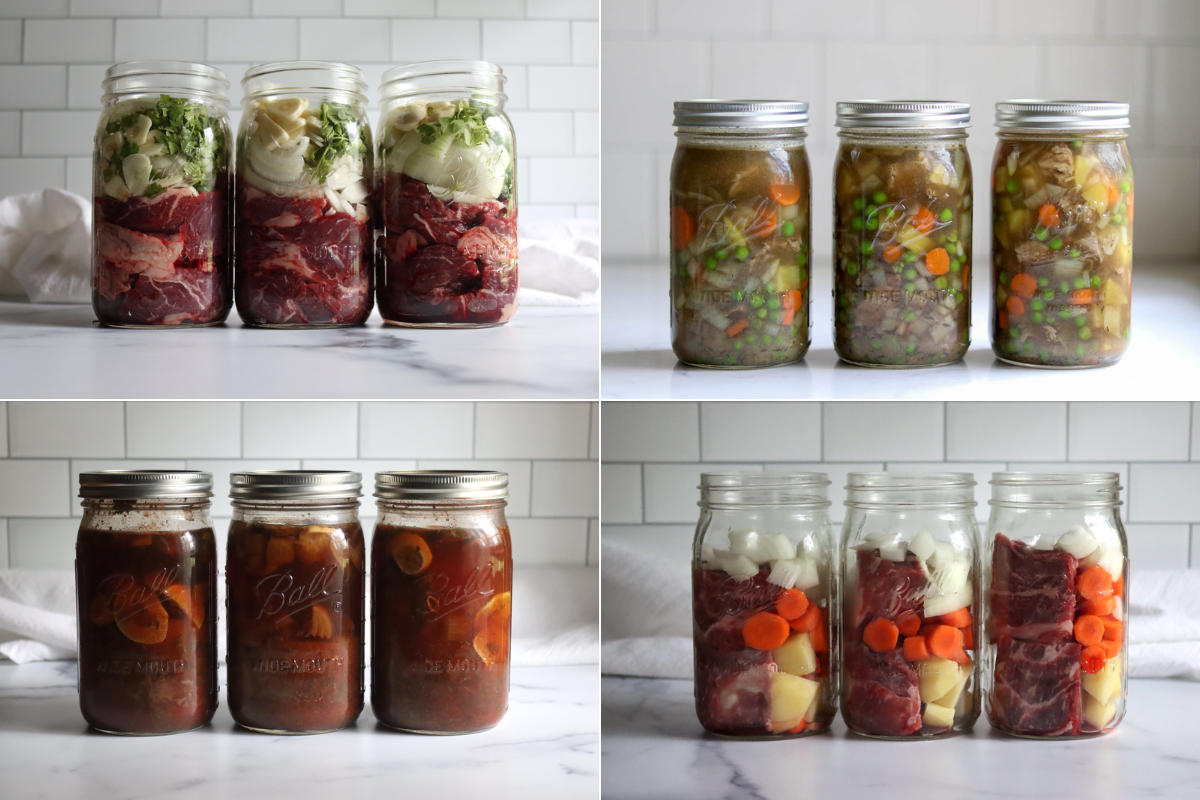
Ground Beef
Ground beef is also an excellent option for canning. It’s perfect for creating easy-to-use, economical meal-in-a-jar recipes. I love using it for chili, taco filling, and Sloppy Joe Filling.
It may sound strange, but you can also can plain ground beef and hamburger patties. Once you take them out of the jar, you can cook them like a regular hamburger, brown the outside crisp, and serve them just like a regular hamburger.
- American Chop Suey (Goulash)
- Canning Hamburger (patties or crumble)
- Ground Beef Chili (Chili con Carne)
- Mincemeat Pie Filling
- Salisbury Steak
- Savory Beef and Vegetables
- Sloppy Joe Filling
- Taco Meat (Ground beef and seasoning)
- Unstuffed Cabbage Rolls
- Unstuffed Pepper Soup
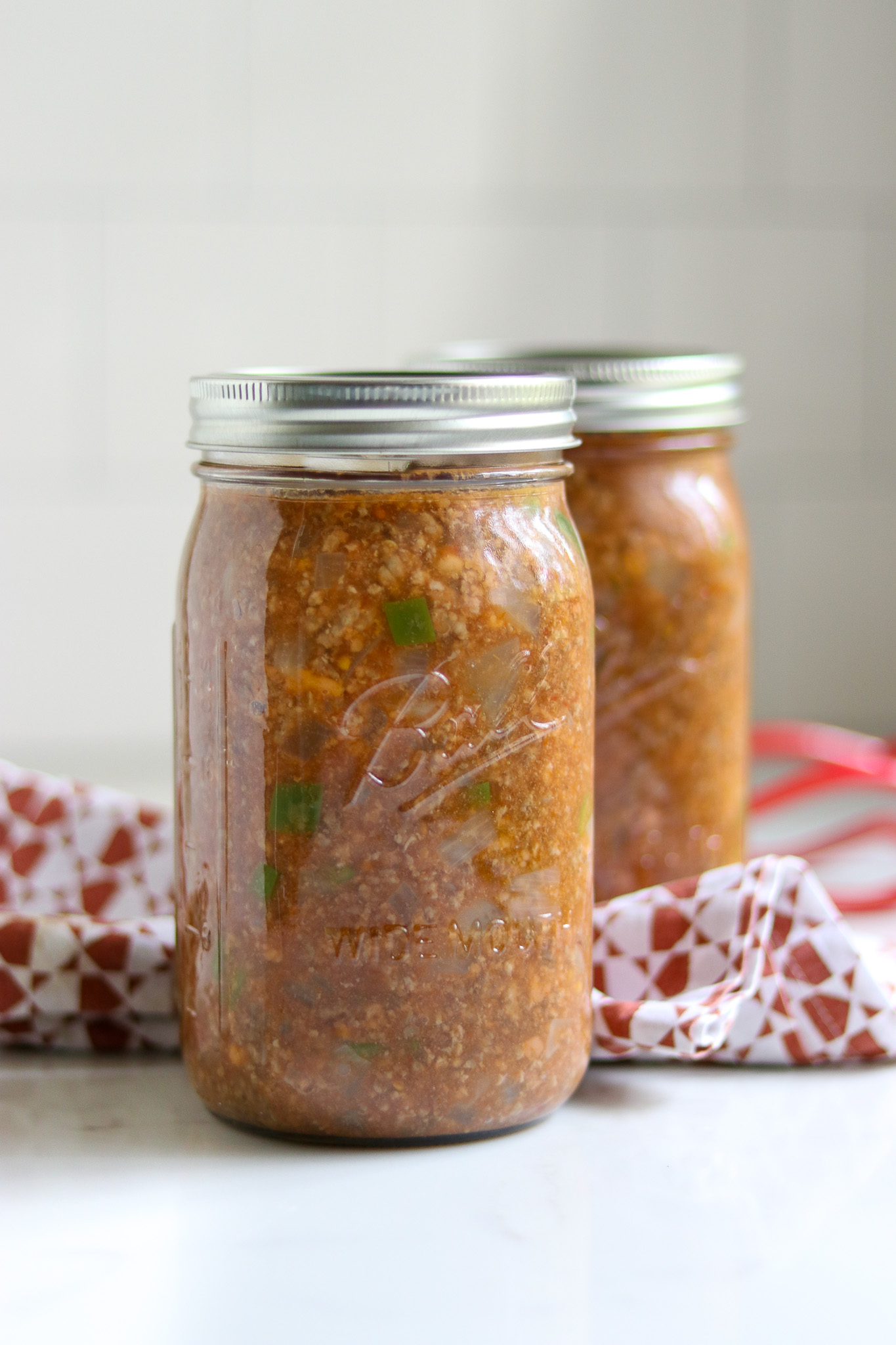
Pork
Pork is easy to pressure can, too! It’s similar to canning beef; you can preserve it as slices, steaks, cubes, or ground pork.
However, this only applies to fresh pork. Cured pork products like ham and bacon aren’t safe for pressure canning. Curing makes meat denser, and it doesn’t reliably heat the same way raw meat does.
That said, there are a few tested canning recipes that use ham or bacon, like Boston Baked Beans. These recipes have been specifically tested and only include a small amount of cured meat for flavor.
You shouldn’t add more to these recipes or try to can a whole jar of ham or bacon. So far, there is no safe way to do that. However, if you’re interested, there are ways to cure your pork at home so it can be stored without canning.
Here are a few safe ways to pressure can pork:
- Mississippi Pork Roast
- Quebec Pork Meatballs
- Pork Meatballs
- Pork Sausage
- Pork Spareribs
- Pork Tenderloin
- Pennsylvania Pot Roast
- Pulled Pork
- Pork and Apple Curry
- Roast Pork in Apple Broth
- Char Siu Pork
- Pork Al Pastor
- Pozole Rojo
- Sausage Crumbles or Patties
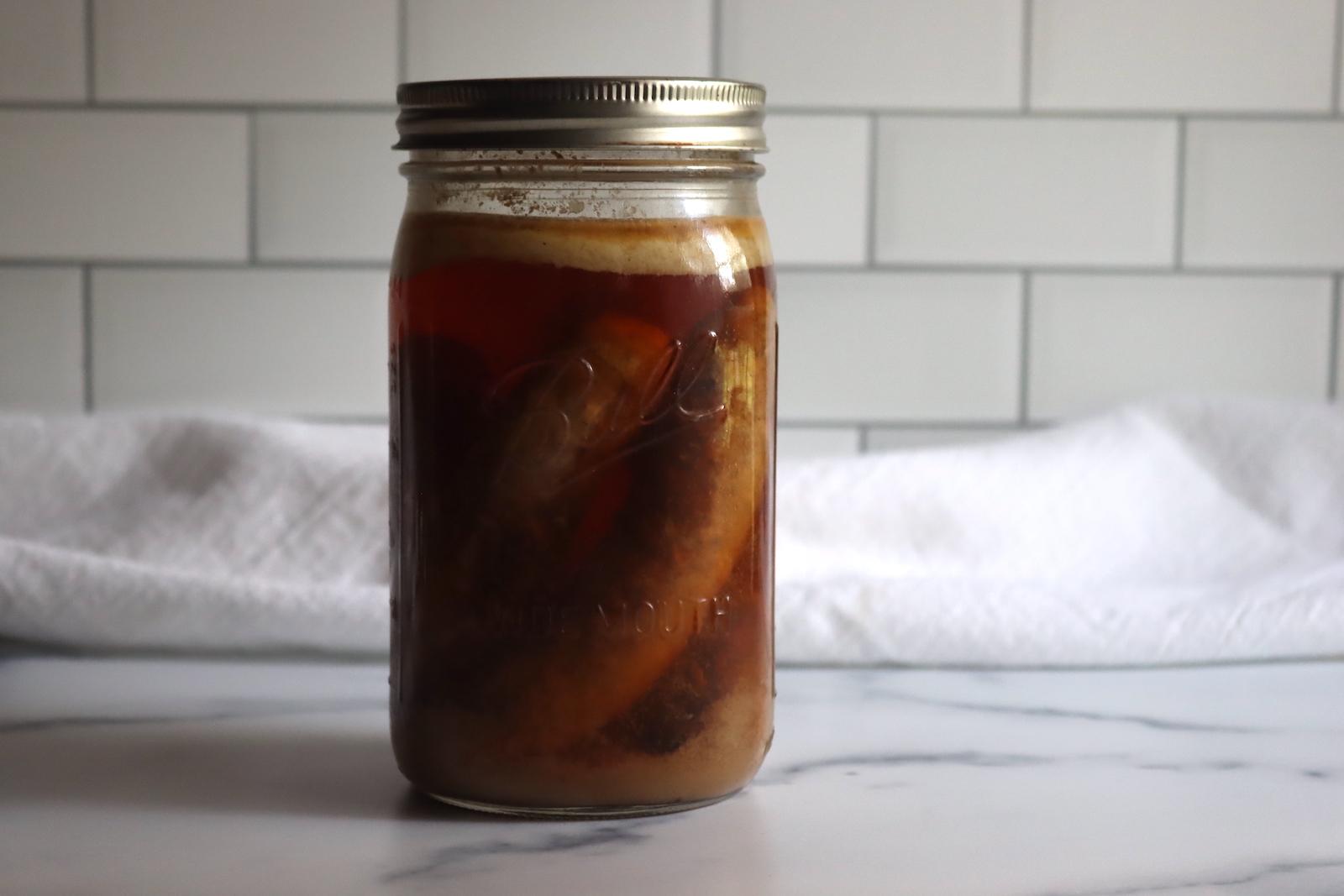
Chicken, Duck, & Rabbit
Chicken, duck, rabbit, and other poultry and small game, including goose, partridge, game birds, and squirrel, can all be canned the same way.
Depending on your recipe, you can pressure can your poultry boneless or bone-in. Surprisingly, bone-in canning is processed for less time because the bones are excellent conductors of heat, and they actually heat up the center of the jar faster than with boneless canning recipes. It may also be easier to remove the bones after canning, once the food is cooked.
However, canning bone-in meat generally means you get less usable meat in each jar, but I still think it’s a good option sometimes, especially for small pieces that are hard to bone raw, like wings and legs.
I have some other chicken canning recipes, but these are my favorite meal-in-a-jar recipes using chicken, duck, and rabbit:
- Canning Chicken: Breasts, Thighs, Drumsticks, or Wings
- Chicken and Gravy Dinner in a Jar
- Chicken Taco Meat
- Chicken Pot Pie Filling
- Chicken Soup
- Thai Red Curry Duck (or Chicken)
- Sweet and Sour Chicken
- Butter Chicken
- Chicken Marsala
- Chicken Piccata
- Firecracker Chicken
- Chicken a la King
- Chicken Salad in a Jar
- Chicken Poblano
- Chicken Cacciatore
- Chicken Normandy
- Chicken Dijon
- Chicken Paprika with Vegetables
- Chicken Fajitas in a Jar
- Spicy Chili Lime Chicken
- Huli Huli Chicken
- Rosemary Chicken
- Greek Seasoned Chicken
- Spicy Chicken
- Asian Seasoned Chicken
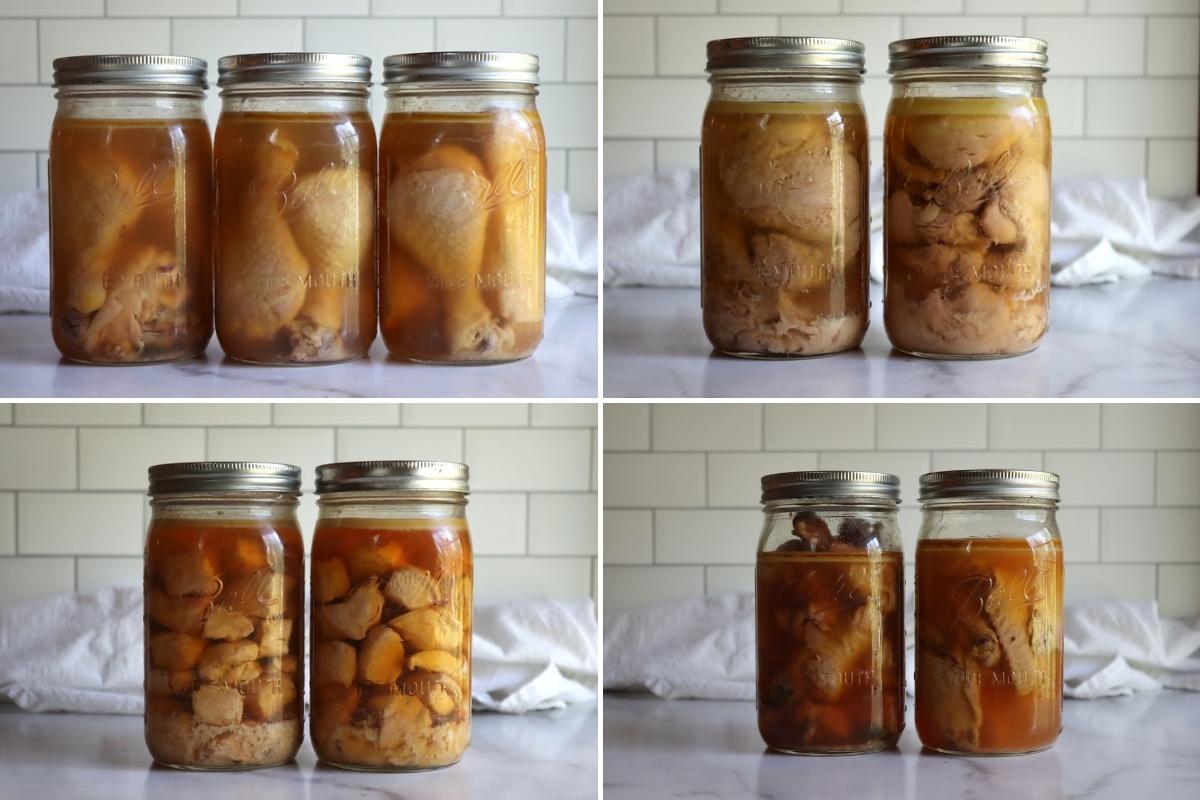
Fish
You can also pressure can several types of fish and seafood, which make good main dishes. These can be helpful recipes if you catch fish yourself or find some on sale. Here are a few of my favorites:
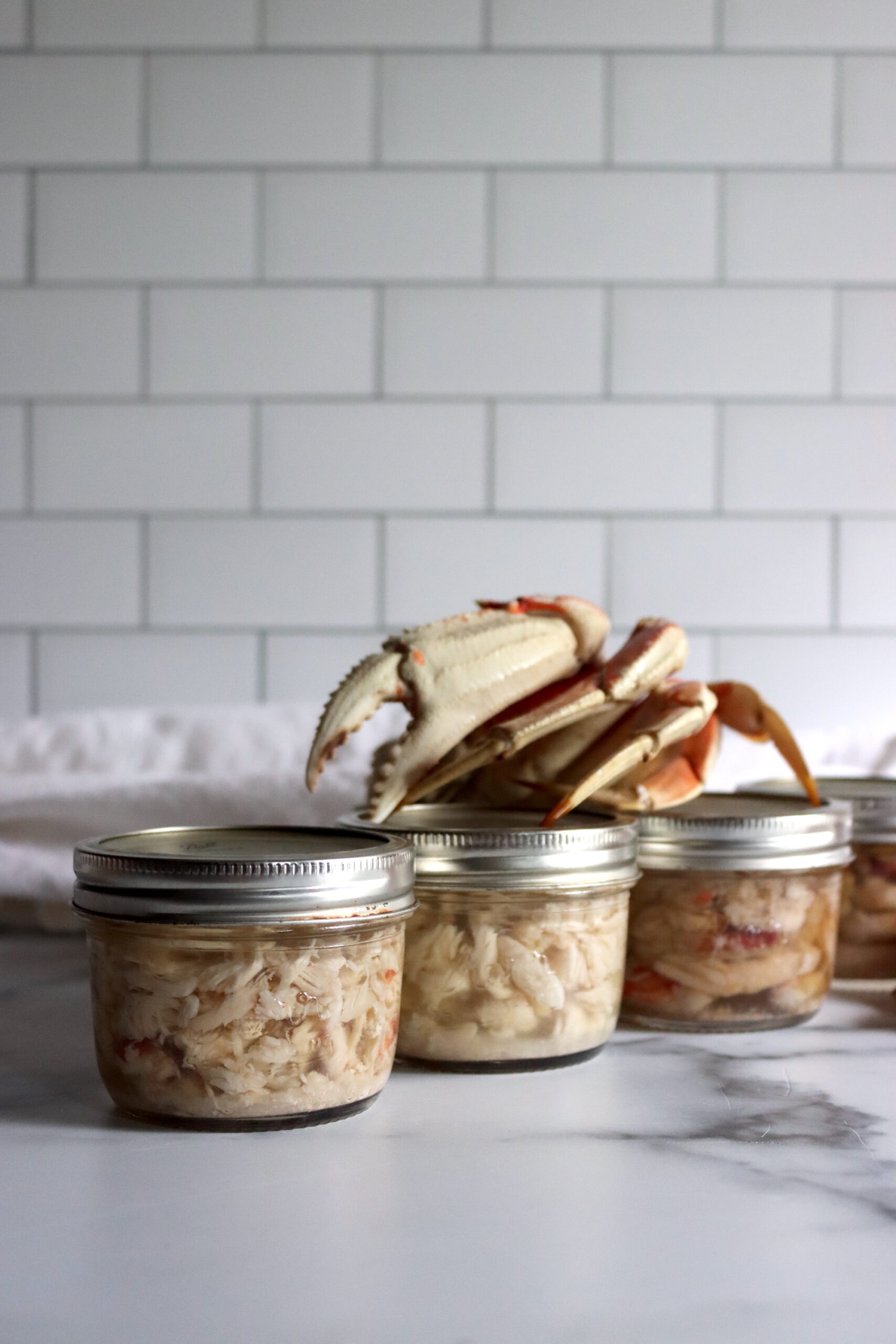
Vegetarian Meal-in-a-Jar Canning Recipes
While the above recipes rely on meat as the star of the meal, there are plenty of tasty, meatless meal-in-a-jar recipes. They’re a great way to use beans and vegetables from your garden during the summer months.
Enjoy tasty meals like chili, baked beans, soups, and more:
- Asparagus Soup
- Beans with Tomato or Molasses Sauce (Vegetarian)
- Canning Beans
- Canning Cream of Mushroom Soup Base
- Carrot and Fennel Soup
- Curried Carrot and Ginger Soup
- Four Bean Salad
- Classic Vegetable Soup
- Green Tomato Pie Filling
- Lentil Soup (use vegetable stock)
- Potato Leek Soup
- Tomato Soup Concentrate
- Spiced Tomato Soup
- Spicy Tomato Vegetable Soup
- Vegetarian Chili Beans
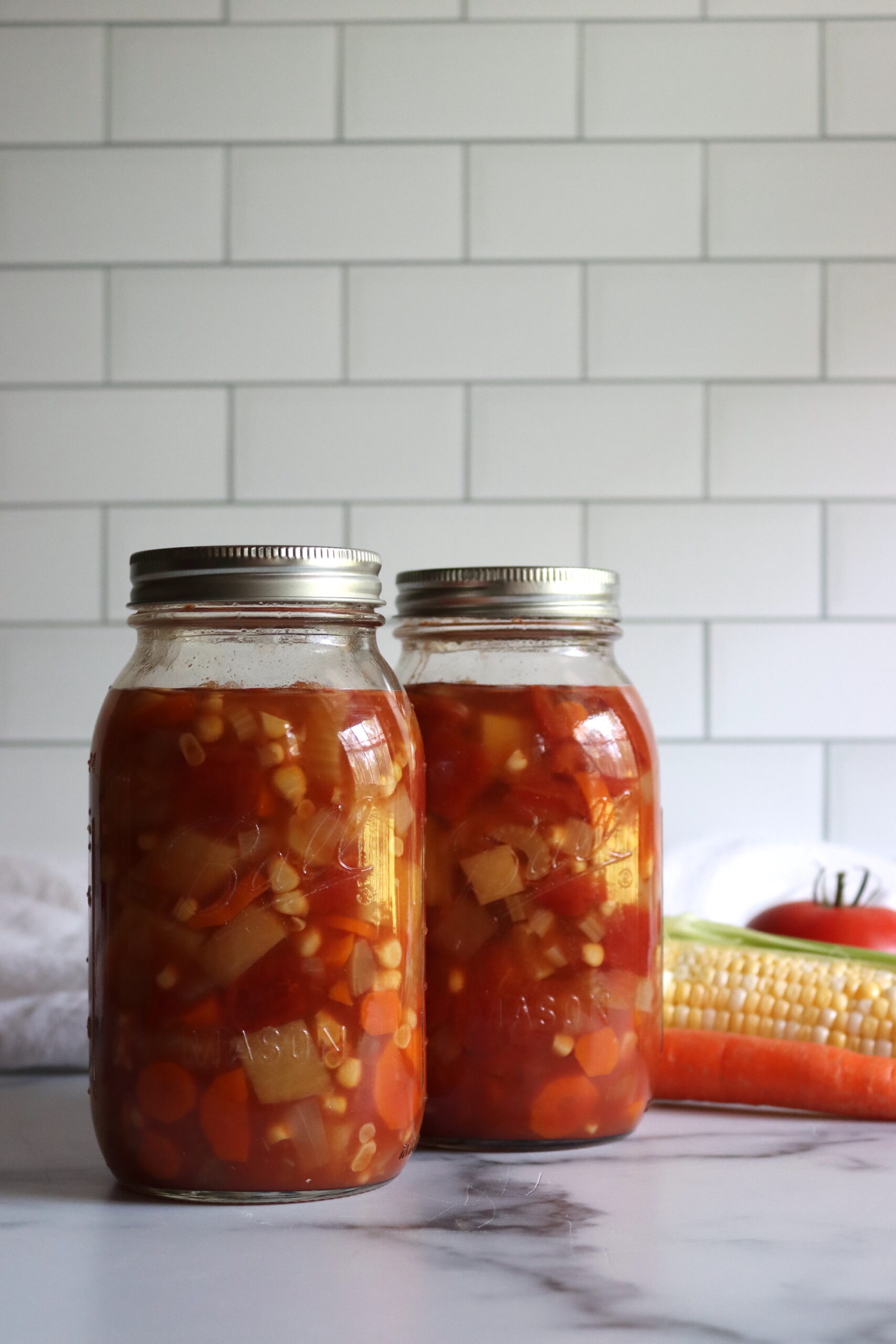
Chili Canning Recipes
Chili is one of my winter go-to’s for quick meals that are filling and comforting. Chili con carne is always a classic choice, but there are many unique recipes, like white bean and chicken chili, to mix things up.
I love serving these ready-to-go chilis with cornbread, baked potatoes, or nachos. These recipes allow for so much variety!
Beef Chili Canning Recipes
These recipes all call for beef, but you can substitute any red meat. If you need to preserve venison, elk, moose, or bear during hunting season, try making chili with it.
- Meat Lovers Chili (Ground Beef, No Beans)
- Classic Chili con Carne (with Ground Beef and Beans)
- Beef Chuck Chili (Beef Chuck, No Beans)
- Chipotle Ground Beef Chili (Ground Beef, No Beans)
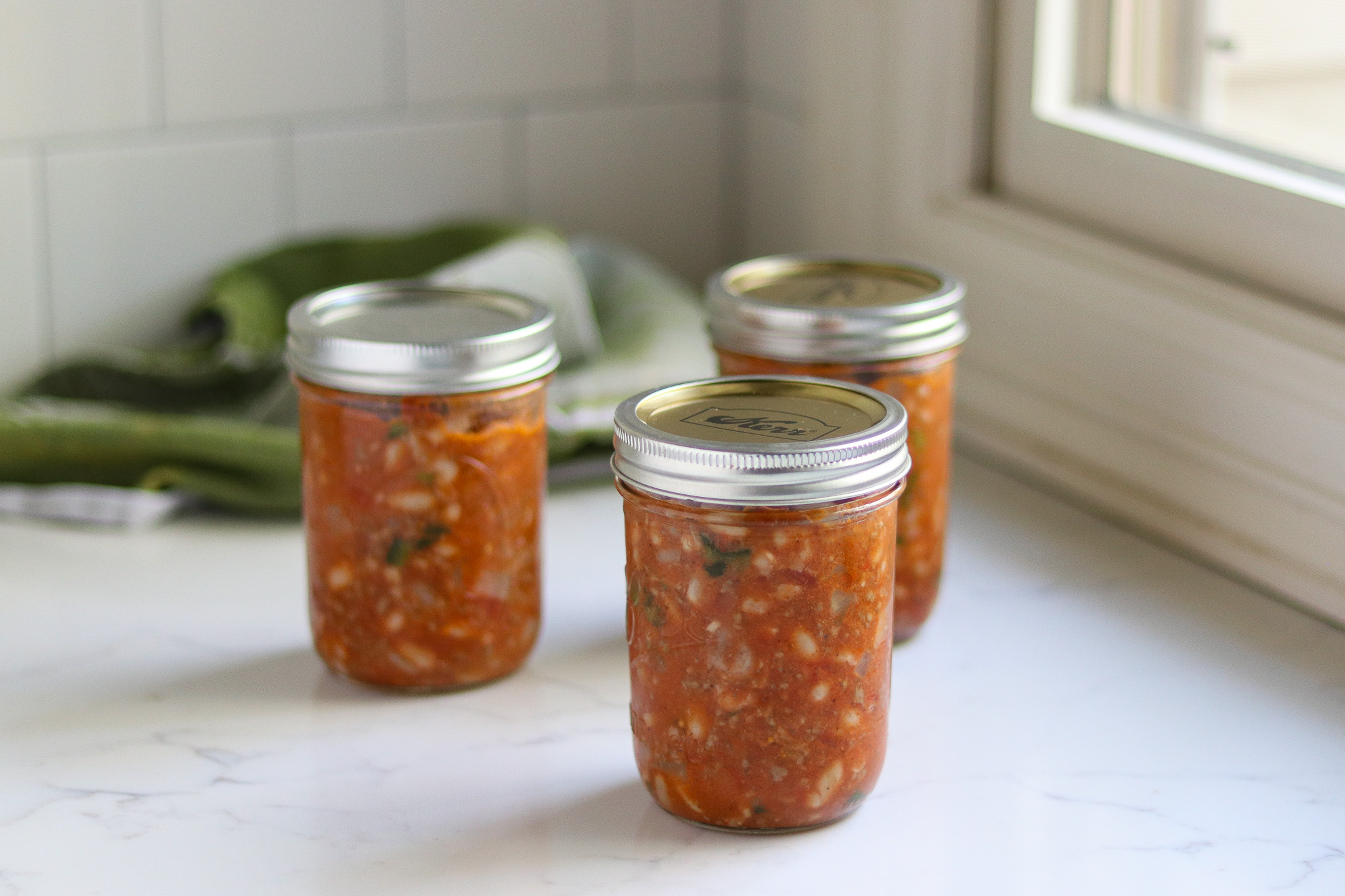
Chicken Chili Canning Recipes
Most traditional recipes call for red meat, but you can also make delicious chili with chicken! These chicken recipes usually call for light beans rather than kidney beans and leave off the tomato.
These recipes are hearty, like traditional chili, but offer a new twist.
You can also substitute other poultry into these recipes to use up goose, turkey, or duck you have processed on your homestead or got on sale.
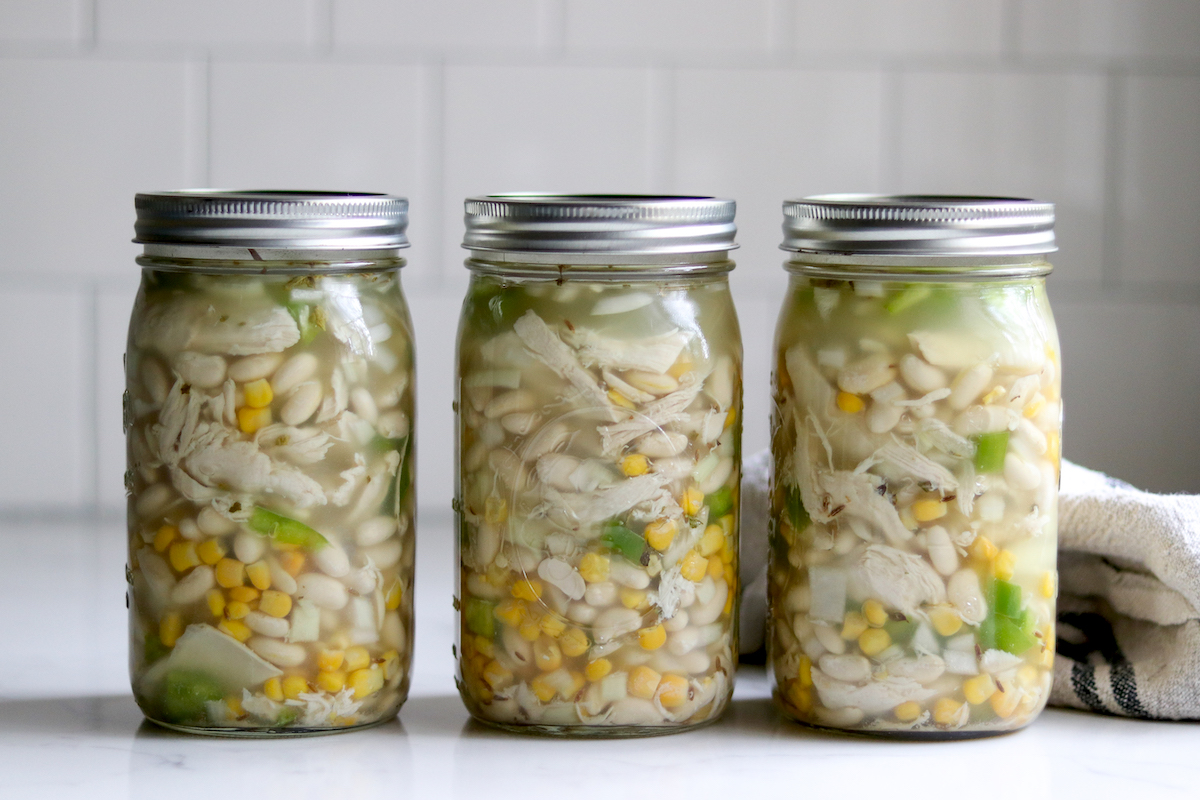
Other Chili Canning Recipes
Sometimes, I substitute other meat into beef recipes, but there are a couple of recipes specifically designed for other meat that I enjoy.
Meat and Bean Canning Recipes
This category may seem similar to chili, but a lot of chili doesn’t even include beans. Plus, there are so many great meat and bean combinations that I felt it needed its own category.
Here are a few excellent meat and bean canning recipes:
- Beans with Salt Pork and Tomato Sauce
- Boston Baked Beans
- Burrito Filling
- Charro Beans
- Drunken Beans
- Hoppin’ John
- Cajun Red Beans and Andouille Sausage
- Chicken Fajita
- Chili Con Carne (Ground Beef Chili and Beans)
- Louisiana Red Beans
- Spicy Chicken with Canary Beans
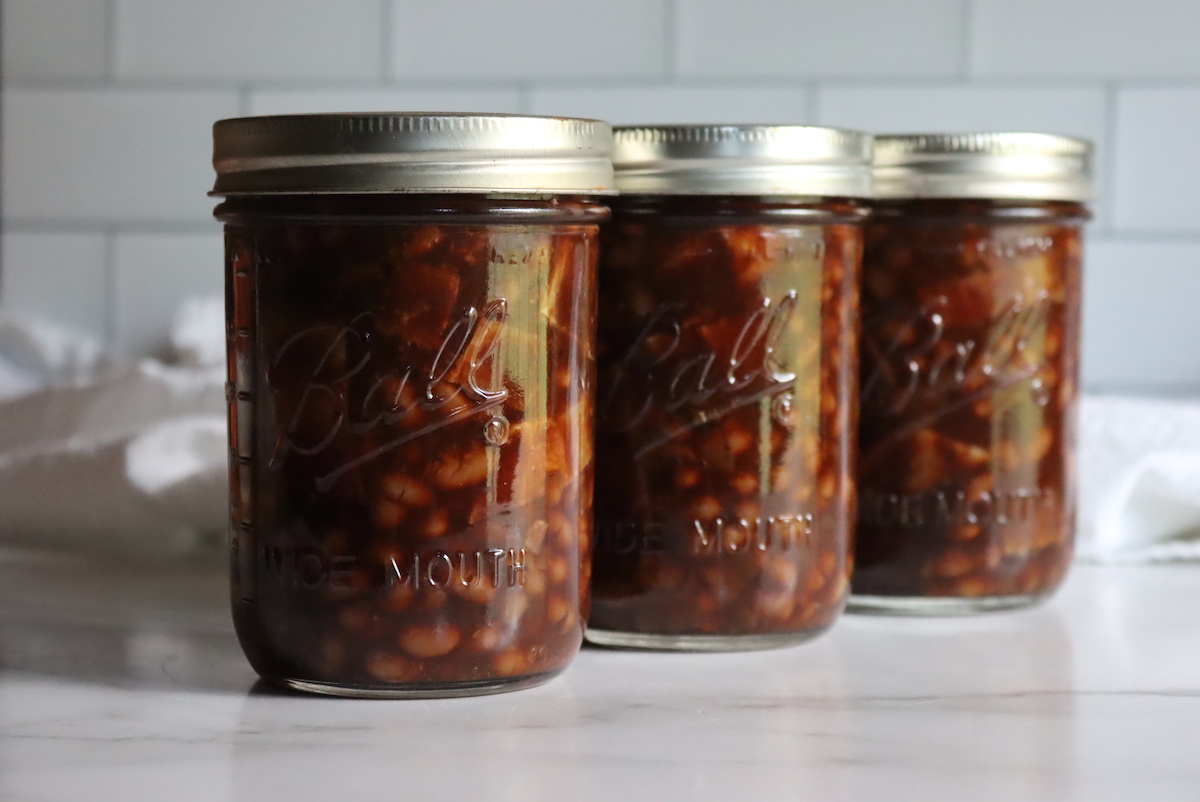
Soup Canning Recipes
Canning soup is one of the easiest ways to create ready-to-go meals. Whether you need something extra nourishing for when you’re under the weather or just need something quick, canned soup is a great option. It’s also much more flavorful and healthy than store-bought canned soup.
I have a separate list with more than 100 soup canning recipes, but here are a few of my favorites:
- Bean & Ham Soup
- 15 Bean & Ham Soup
- Butternut Squash Soup
- Butternut Squash and White Bean Soup
- Clam Chowder
- Classic Beef Stew
- Classic Chicken Soup
- Chicken and Corn Chowder
- Chicken Mexican Soup
- Chicken Tortilla Soup
- Chicken Vegetable Soup
- French Onion Soup
- Habitant Soup with Ham (Split Pea Soup)
- Hamburger Soup
- Hamburger Vegetable Soup
- Italian Meatball Soup
- Mexican Chicken Soup
- Potato Soup
- Rosemary White Bean Soup Starter
- Sausage and Bean Soup
- Sausage, Kale, and White Bean Soup (Copycat Olive Garden Zuppa Toscana)
- Sopa de Albóndigas (Mexican Ground Beef Soup)
- Southwestern Chicken Soup
- Split Pea Soup with Ham
- Steak and Ale Soup
- Stuffed Pepper Soup
- Taco Soup
- Thai Coconut Squash Soup
- Turkey Chili Soup
- Turkey and Vegetable Soup
- USDA’s “Your Choice” Soup
- Vegetable Beef Stew
- White Bean and Kale Soup
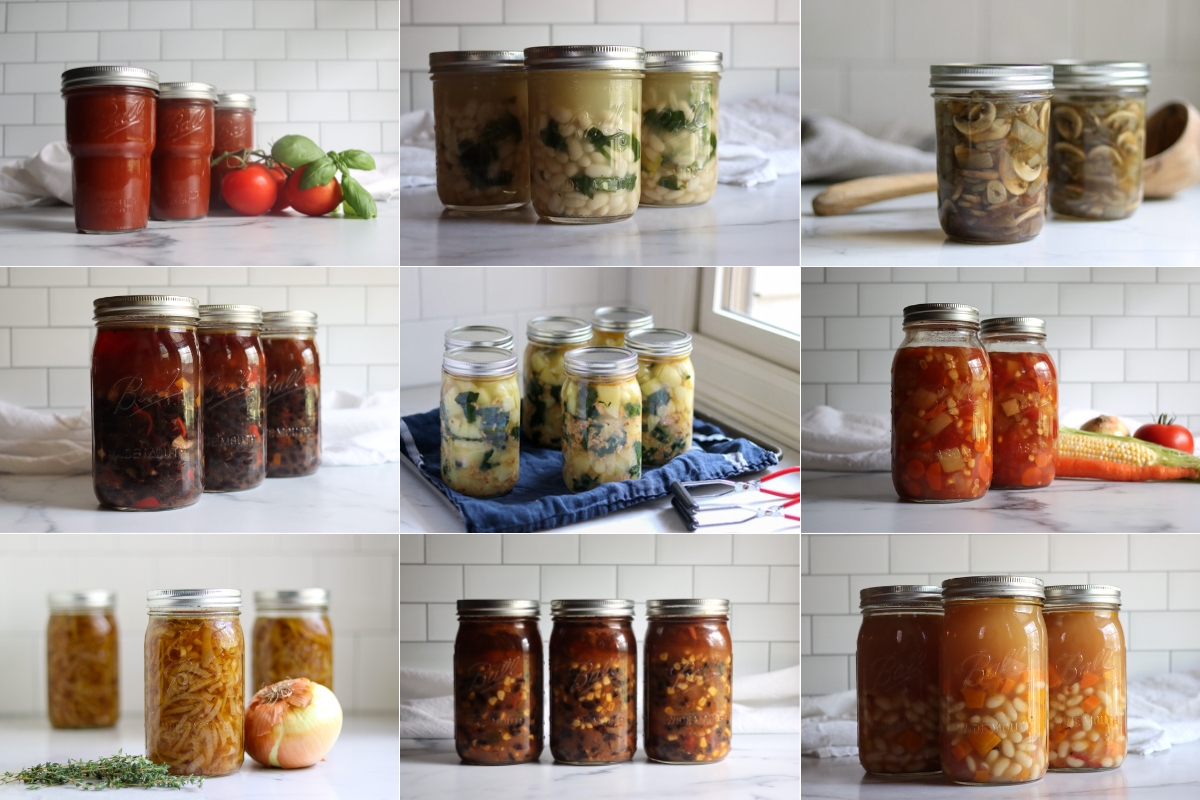
Other Meal-In-A-Jar Ideas
There are also several other canning recipes that include most of a meal. While recipes like pasta sauce with meat aren’t technically a whole meal, heated alongside some fresh pasta, they quickly provide a homemade dinner.
These are my favorite recipes that make up almost an entire meal:
- Bruschetta
- Classic Pasta Sauce (no meat)
- Eggplant Pasta Sauce Alla Puttanesca
- Minnesota Mix
- Pasta Sauce with Meat
- Pizza Sauce
- Roasted Marinara Sauce
- Tikka Masala Simmer Sauce
- Venison Spaghetti Sauce
- Vodka Pasta Sauce
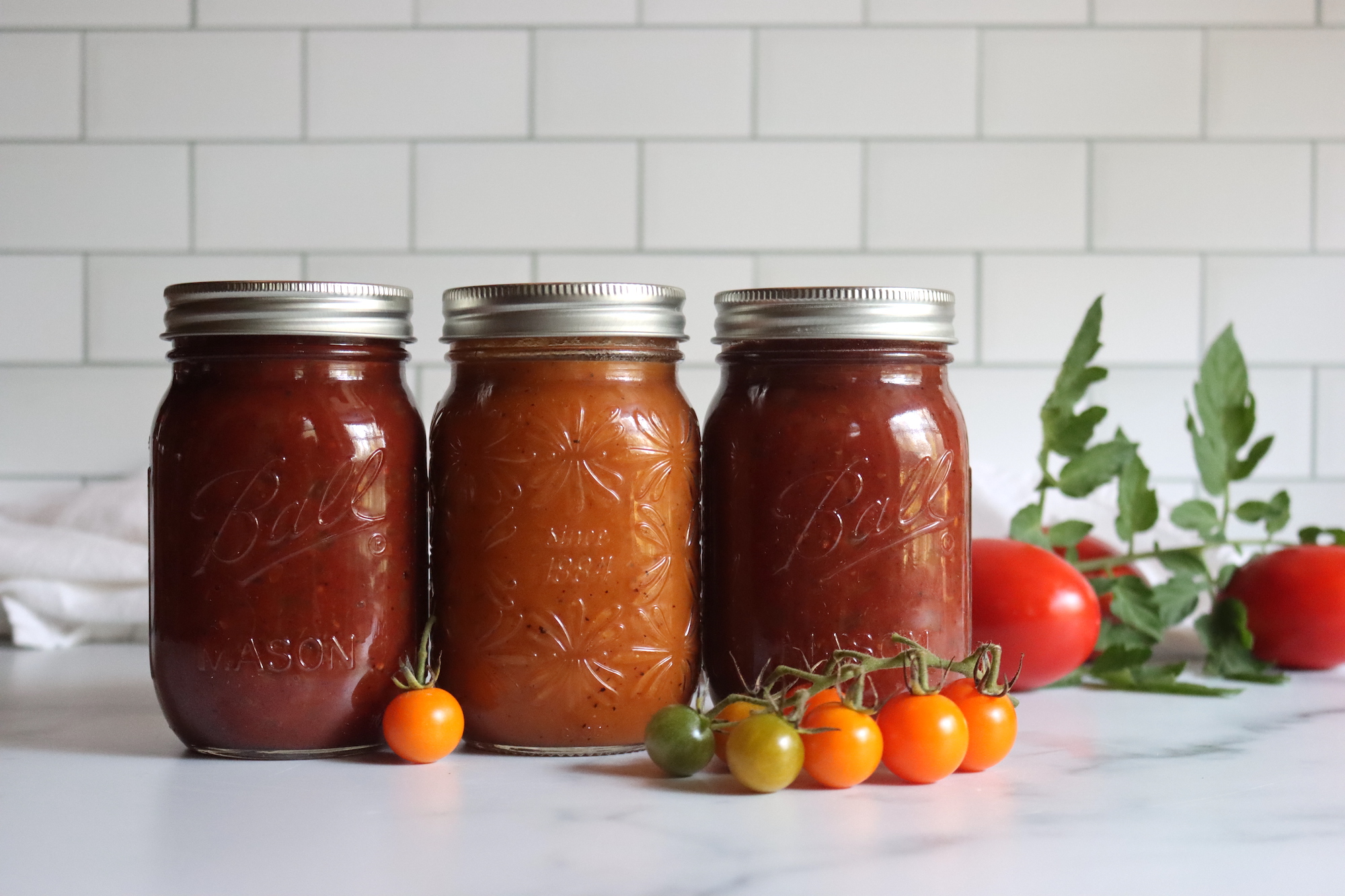
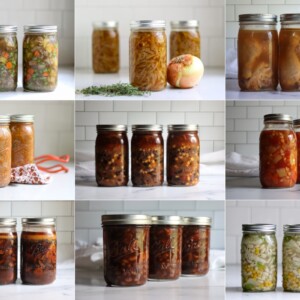
Meal in a Jar Canning Recipe
Ingredients
Ingredient Choices for Both Meal Types
- Fresh vegetables, e.g., carrots, onions, green beans
- Meat, e.g., beef, chicken, pork (cut into cubes)
- Fish or seafood, in bite-sized pieces
- Pre-soaked and fully cooked beans, Only for Brothy Meals, see notes
- Broth, or stock, water, or wine
- Herbs and spices, fresh or dried, to taste
Instructions
For Brothy Meals (Half Filled Jars):
- Choose only ingredients that are approved for canning (no flour, dairy, cheese, bread or thickeners).
- Prepare Ingredients as you would for canning them individually. Vegetables: Wash, peel if needed, and chop. Pre-cook dense vegetables like carrots. Meat: Cook until tender, remove excess fat and bones, then cut into bite-sized pieces. Brown ground meats. Fish/Seafood: Cut into small chunks, fish bones can remain. Beans: Fully rehydrate by soaking overnight.
- Combine Ingredients: Mix prepared solids in a large pot. Add enough liquid to cover plus 2-3 inches. Bring to a boil, simmer for 5 minutes. Add herbs and spices.
- Fill Jars: Use a slotted spoon to fill jars halfway with solids. Add hot liquid, this time filling the jar to nearly the top, leaving 1-inch headspace. The jars should be half solids, and the remaining space is filled with broth/water. Remove air bubbles, wipe rims, and secure lids.
- Process in pressure canner: 60 minutes for pints, 75 minutes for quarts. For seafood recipes, process both pints and quarts for 100 minutes. Adjust pressure for altitude (see notes).
- Cool and Store: Allow jars to cool completely before checking seals. Store sealed jars in a cool, dark place.
For Hearty Meals:
- Choose only ingredients that are approved for canning (no flour, dairy, cheese, bread or thickeners). With hearty meals, you cannot use dry beans, leafy greens, winter squash, sweet potatoes, or creamed corn. Those are only allowed in brothy meals with half filled jars.
- Prepare ingredients as you would for brothy meals above.
- Combine Ingredients: Add all prepared solids to a large pot, cover with hot broth. Bring to a boil, simmer for 5 minutes.
- Fill Jars: Pack jars with solid ingredients to 1-inch from top. Add hot broth to maintain 1-inch headspace. Remove air bubbles.
- Process in pressure canner: 75 minutes for pints, 90 minutes for quarts. For seafood recipes, process pints only for 100 minutes. Adjust pressure for altitude (see notes).
- Cool and Store: Let jars cool completely. Check seals before storing in a cool, dark place.
Notes
- Brothy meals: Jars should be half-filled with solids before adding liquid, then fill with liquid to 1-inch headspace. Beans will expand during canning.
- Hearty meals: Jars are mostly filled with solids to 1-inch headspace. Do not include dry beans, leafy greens, winter squash, sweet potatoes, or creamed corn.
- Never add: Dairy products, thickeners, pasta, rice, or ingredients without specific canning guidelines.
- Prepare all ingredients according to individual canning recommendations.
- Seafood in hearty meals can only be canned in pint jars.
- Minimum batch size: 2 quarts or 4 pints. Maximum depends on canner capacity.
- Shelf life: Indefinite if properly sealed, but best quality within 12-18 months. Always check seals before use.
Raw Pack or Hot Pack
This customizable recipe uses hot pack because that’s the way the guidance was developed at the NCHFP. The main reason is quality, as hot packs tend to work better with a wider variety of ingredients. Ball Canning has recently moved to raw pack in all of their pressure canning meal in a jar recipes because it’s so much more convenient to just put raw ingredients into a jar and top with hot broth. The NCHFP has not adopted this guidance as of yet, so I’ve stuck with the hot pack here.Altitude Adjustments
Canning times are the same regardless of altitude, but you do need to adjust the pressure at higher altitudes. Dial Gauge Canner:- 0-2,000 ft: 11 lbs pressure
- 2,001-4,000 ft: 12 lbs pressure
- 4,001-6,000 ft: 13 lbs pressure
- 6,001-8,000 ft: 14 lbs pressure
- 0-1,000 ft: 10 lbs pressure
- Above 1,000 ft: 15 lbs pressure
Reheating
- Stovetop: Simmer in a saucepan for 10 minutes.
- Microwave: Heat in jar after removing metal lid and ring.
Nutrition
Nutrition information is automatically calculated, so should only be used as an approximation.
Canning Recipe Guides
Here are a few great sources for finding other canning recipes to stalk your pantry.
- 20+ Ground Beef Canning Recipes
- 12+ Pumpkin, Butternut, & Winter Squash Canning Recipes
- 20+ Pie Filling Canning Recipes
- 20+ Chicken Canning Recipes
- 12+ Corn Canning Recipes
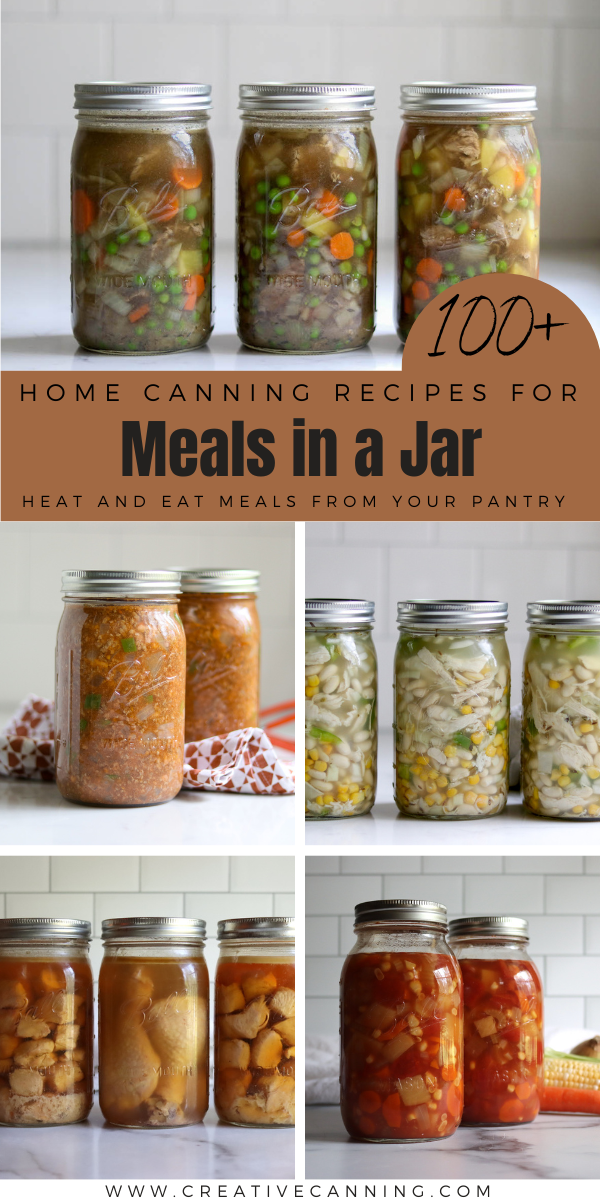
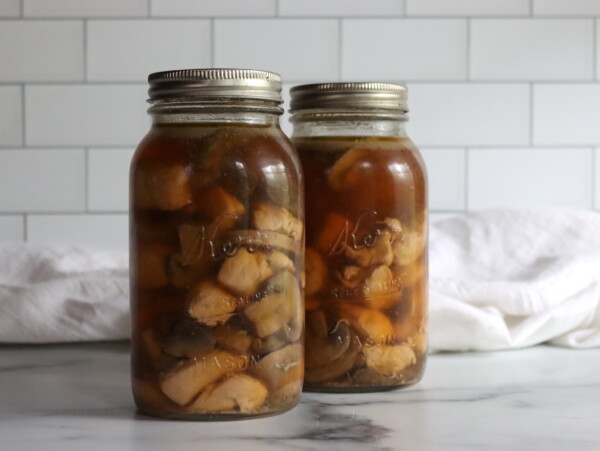
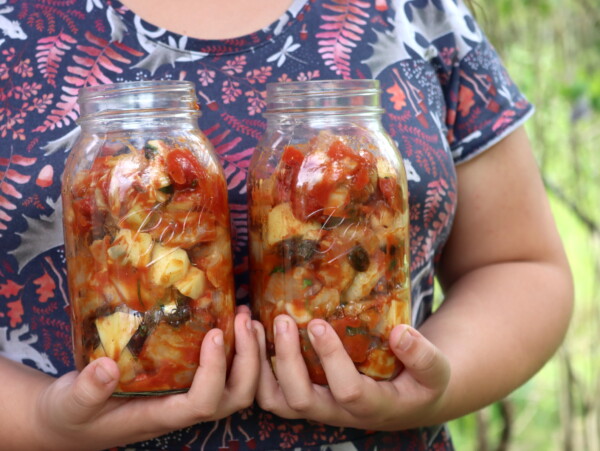
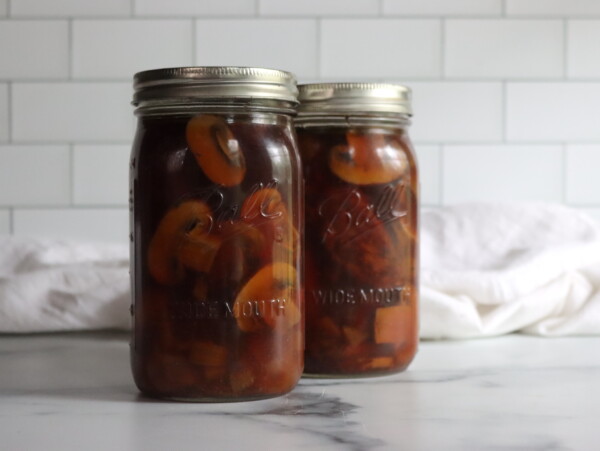
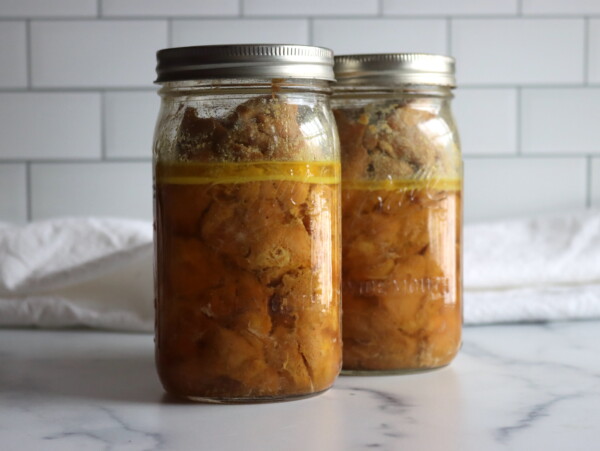
We have made so many of these recipes and loved every single one!
OMG, thank you sooo much for this. I love your content and look forward to your updates as your littles grow. Ashely, you are divinely in service to others. Thank you for giving so much of yourself. Many may not speak. I have been mostly silent, tho I am compelled to speak now. What a gift of not only your experience, expertise, but of research and compilation. I love that you are so giving of your life experience for others. May you continue to be blessed and a lighthouse to others. Namaste. KundaLisa
Thank you so much!
I applaud you for the incredible amount of research and work you did to prepare this.
That being said, I was very disappointed to find out most of the recipes basically cook everything before you can it.
I’ve been canning a long time and 99% of what I can is raw packed as pressure cooking for 90 minutes quarts and 75 minutes pints certainly cooks the food as well as preserving it.
I have followed you since you started, and I am amazed at hoe incredibly informative and varied the information you are sharing.
In fact, I have stopped about 75% of my other followed individuals regarding food and homesteading because you cover it all so well.
I want to thank you very much and although at 82 I don’t have the need I still get great enjoyment out of knowing there are people like you out there preserving the heritage.
Hello Ann-Marie! (love your name! It is my middle name and my daughters middle name). I stumbled upon this website while searching recipes. As a lover of all things “comment section” I see one lonely single comment, yours. What astonished me and kind of annoyed me(politest word I got) is that this being a single comment, the author most definitely could take a few seconds to acknowledge your single comment. I mean, I understand that there’s no obligation, just as there’s no obligation for anyone to be on her site. My grandmother canned and quilted up to the last few months of her life, in her 90’s, and I’ve missed her, her knowledge, so much since 2017. The art of canning (&quilting)(yes its an art) needs people to be interested in the knowledge as they was in years gone by. Im delighted there are a few homesteaders sharing knowledge to continue traditions etc. I don’t think any generation will take the place of your generation or my grandmothers generation. Times are different, and we have change, unfortunately not all good. I wanted to reply to you to say thank you because I know you have passed knowledge on somewhere. In fact, I feel this author should have personally taken time to just offer a simple “thank you” for being a long time dedicated reader/supporter of her work. Its not hundreds of comments she had to scroll through, just a single comment. A simple acknowledgment atleast shows a bit of appreciation. Not too difficult, in fact one should be humble enough to take a few minutes to offer “thanks” to you, who at 82 yrs is reading and following someones work to whom you likely could offer her knowledge that she doesn’t have. Anyway, I do hope you see this. Know that you’re appreciated Ann-Marie.
Hey Jessica, Thanks for replying. You’re right, I don’t have a lot of comments on this particular post…but I do have literally thousands on this site, and tens of thousands on my other site Practical Self Reliance. And then another 20-50 emails a week from readers in my inbox each week, and then around 50-100 comments each week on my substack. I am literally one person with two kids at home and a homestead to run, putting out new posts every single day. Yup, I’m slow at getting back to the comments sometimes. So I’m glad you’re here to help out. If you’d like to volunteer to help make sure comments get the love they deserve, that’d be absolutely lovely. Thanks!
Thanks Ann-Marie! I agree with you, it is interesting that most recipes online these days are hot pack for meal in a jar recipes. It’s only recently that Ball Canning officially came out with recommendations for raw pack meal in a jar stuff, so until then, people are playing it safe I guess. The other reason, I imagine, is that if you’re taking pictures of jars, the contents come out prettier when you hot pack. Raw pack chicken is delicious…but hot pack looks better in the jar on the shelf (but it’s much more of a pain in the neck than just raw packing).
Glad you’re enjoying the recipes!